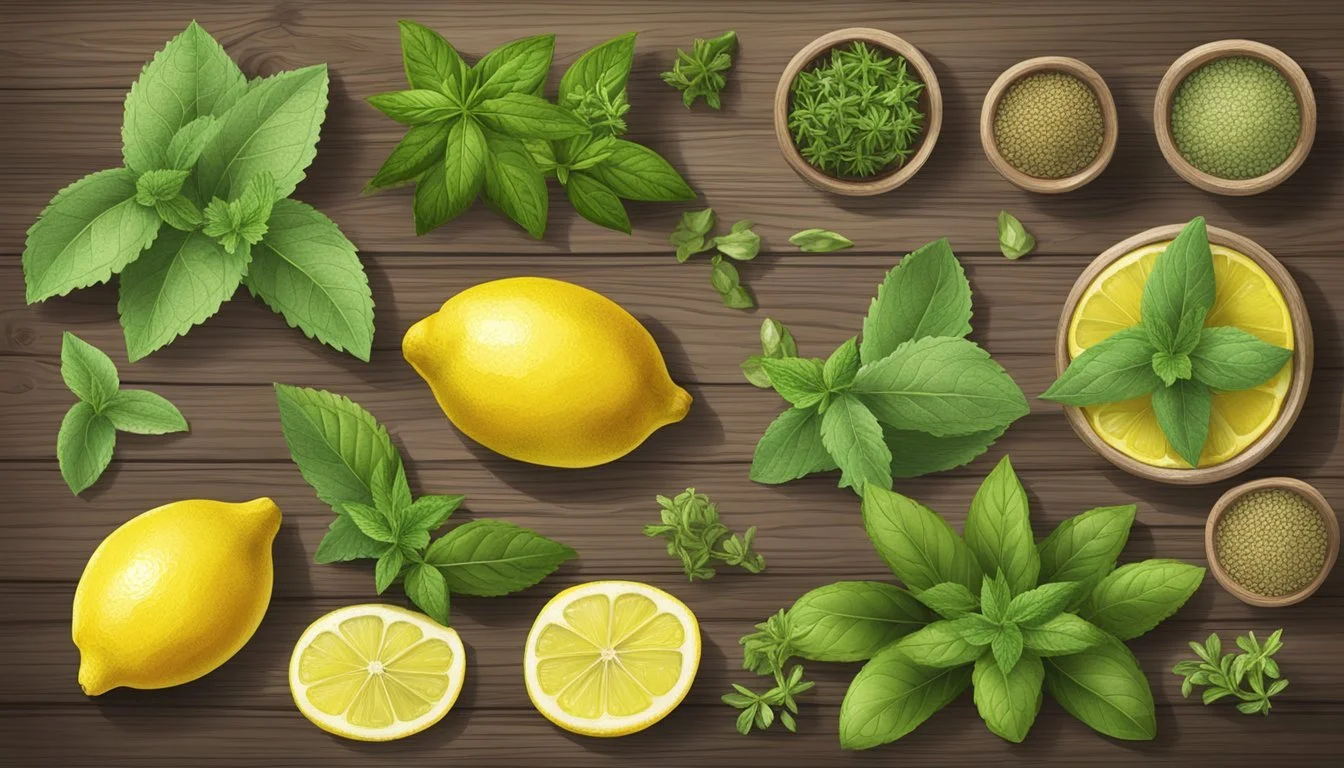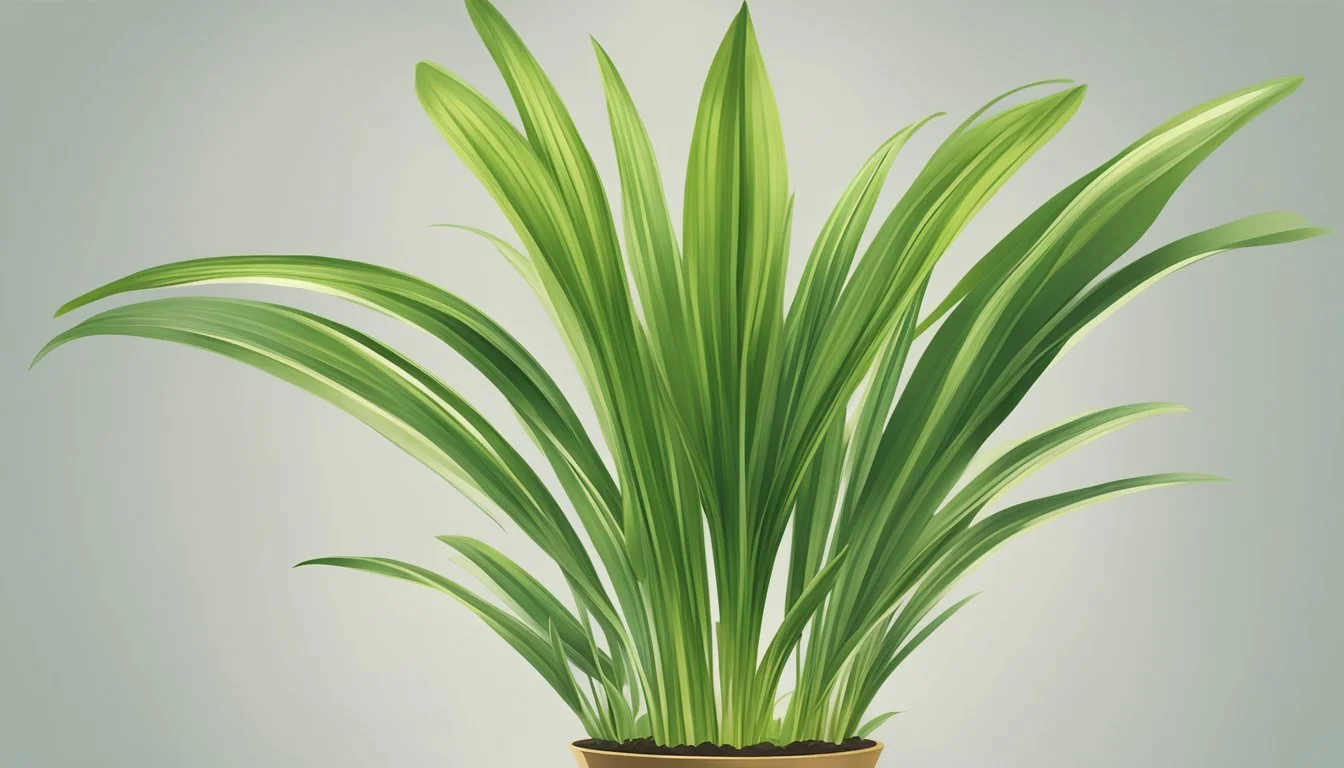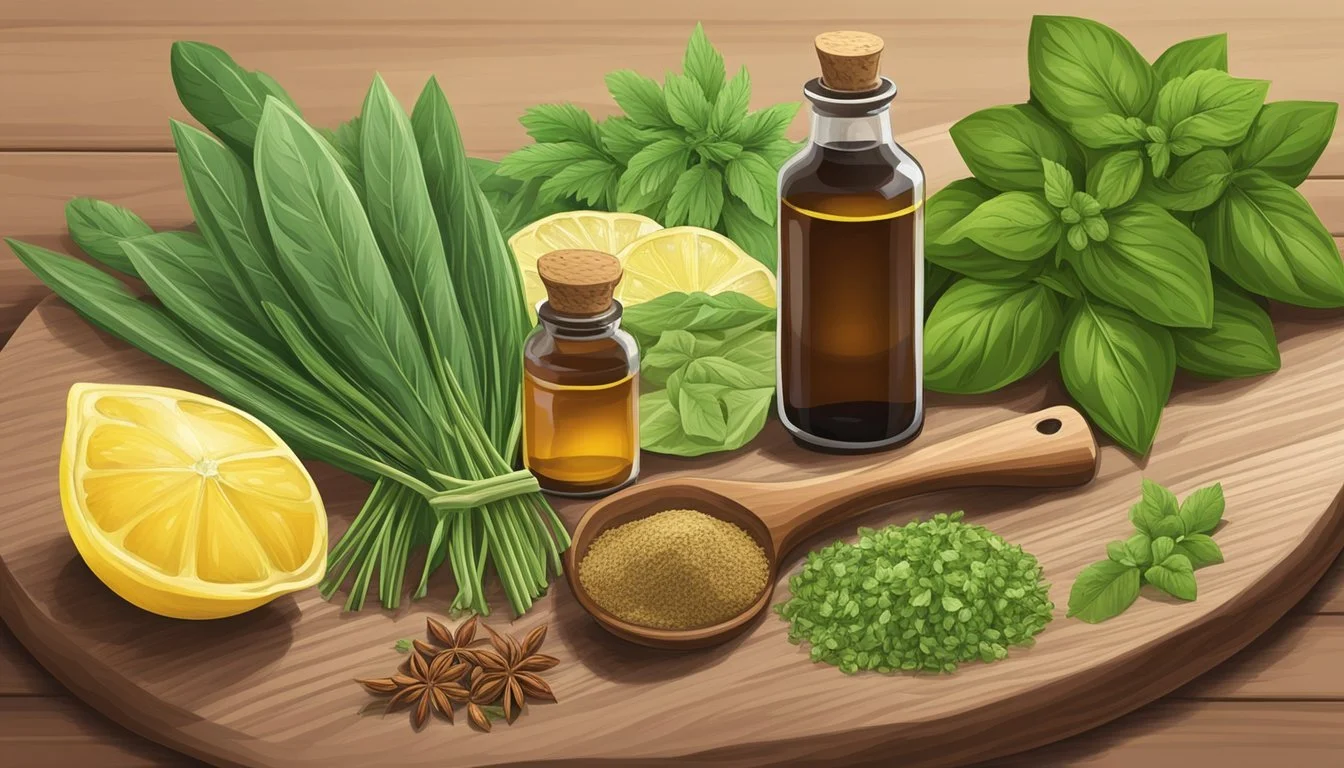Lemongrass Substitutes
Top Alternatives for Your Cooking Needs
Lemongrass is a tropical plant used extensively in Asian cooking, renowned for its unique citrusy flavor and aromatic qualities. It is a versatile ingredient that can enhance the taste of curries, soups, and tea with its lemony zest, yet it is not always readily available in every kitchen. Cooks may need to find substitutes that can mimic the distinct qualities of lemongrass when it is absent from their pantries.
Finding an effective substitute for lemongrass involves replicating its vibrant citrusy essence while complementing the flavors of the dish. A combination of lemon zest and chopped ginger is often suggested for its similarity in imparting a citrusy aroma and a hint of sharpness that is characteristic of lemongrass. Arugula paired with lemon zest can also be used; its herbal notes and a slight peppery taste can approximate the complex profile of lemongrass. These substitutes aim to achieve a balance in flavor when making stews (What wine goes well with stews?), soups, and other dishes where lemongrass would typically be a key ingredient.
Understanding Lemongrass
Lemongrass is fundamental in Thai and Asian cuisines, known for its distinct citrusy flavor and aromatic qualities. Here we explore its culinary significance, flavor characteristics, and health advantages.
Culinary Uses
Lemongrass is an essential herb in Thai cuisine and a variety of Asian cooking practices, prized for its ability to impart a fresh, lemony fragrance to dishes. Commonly found in soups, curries, and teas, lemongrass is versatile in the kitchen. It is used in its fresh form, as well as dried and powdered. The stalks can be bruised and added whole to infuse sauces and broths with its herbal aroma, then removed before serving, or it can be finely chopped and integrated into marinades and spice pastes.
Taste Profile
The taste of lemongrass is unmistakably citrusy with a hint of rose fragrance and an earthy undertone. Its lemongrass taste can be described as:
Bright: Delivers a fresh, zesty citrus note similar to lemon or lime.
Herbal: Contains subtle, green nuances that elevate culinary dishes.
Complex: Exhibits layers of flavor that can range from sweet to slightly bitter.
This complex profile makes it somewhat challenging to substitute but commonly, ingredients like lemon zest and ginger attempt to mimic these dimensions.
Health Benefits
Lemongrass offers several health benefits. It is rich in antioxidants and has been traditionally used for medicinal purposes in many cultures. Some of the notable properties include:
Digestive support: It may help alleviate digestive issues and maintain gastrointestinal health.
Anti-inflammatory: The herbal components might reduce inflammation and pain in conditions like arthritis.
Relaxation aid: With its calming fragrance, lemongrass is also used in aromatherapy for its potential to help reduce stress and improve sleep quality.
In its various forms, lemongrass remains a staple ingredient not just for its culinary attributes but also for its potential contributions to well-being.
Lemongrass Substitutes Overview
In cuisines worldwide, lemongrass imparts a distinct citrusy flavor to dishes. Its unique taste can be mimicked using various substitutes when lemongrass itself is unavailable.
Factors When Choosing Substitutes
When selecting a lemongrass substitute, one must consider the dish's flavor profile and the substitute's impact on the overall taste. Factors like the dish's cooking time and the intensity of flavors desired also play a role. Substitutes should complement the other ingredients without overwhelming them.
Best Overall Substitutes
For a balance between citrus and herbal notes, lemon or lime zest paired with chopped ginger is highly effective. This combination offers an aromatic quality that mirrors lemongrass without altering the intended flavor palette of a dish significantly.
Arugula and Chopped Ginger: Provides a slightly bitter and sweet taste, less lemony, but rich in herbal notes making it a versatile substitute.
Lemon Zest and Chopped Ginger: Citrus-forward and vibrant, appropriate for most recipes calling for lemongrass.
Lemongrass Substitute Options in Cooking
Different substitutes may be better suited for particular applications in cooking:
Stews and Curries: Lemon zest plus chopped ginger adds the necessary citrus flavor.
Soups: A pure lemon grass tea bag steeped in boiling water can infuse the dish with a lemongrass-like essence.
Marinades and Sauces: Lime zest is less acidic and a bit milder, suitable for both sweet and savory dishes.
Southeast Asian Dishes: Cilantro combined with fresh ginger can offer a similar citrusy and slightly spicy edge to dishes typically featuring lemongrass.
Fresh Lemongrass Substitutes
When fresh lemongrass is unavailable, several substitutes can closely mimic its fragrant, citrus flavor in various dishes. These alternatives include readily available fresh herbs and other ingredients that offer a similar aromatic quality.
Lemon Zest
Lemon zest provides a vibrant citrus flavor similar to lemongrass. When using as a substitute in recipes, the zest of one lemon equates to the flavor of one stalk of lemongrass. It's especially useful in marinades, dressings, and sauces.
Lemon Verbena
Lemon verbena is another fragrant herb with a strong lemony scent that makes it an excellent substitute for fresh lemongrass. Commonly used in teas and desserts, it can be steeped or integrated into dishes that call for a lemon flavor.
Kaffir Lime Leaves
For a Southeast Asian touch, kaffir lime leaves offer a distinctive citrus flavor and are often used as a lemongrass substitute in Thai cooking. Typically, a few leaves can substitute for one lemongrass stalk, imparting a floral note to curries and soups.
Lemon Balm
Lemon balm, a member of the mint family, possesses a mild lemon scent and is a suitable substitute for lemongrass in both sweet and savory recipes. Freshly chopped lemon balm can be used in similar proportions to fresh lemongrass to infuse dishes with a light, citrus flavor.
Dried Lemongrass Substitutes
When fresh lemongrass is unavailable, and a recipe calls for its aromatic flavor, one can look to various dried alternatives that preserve the essence of lemongrass to a certain degree. These substitutes are particularly useful for stewed dishes, soups, and curries.
Dried Lemongrass Powder
Dried lemongrass powder, also known as ground lemongrass, is made from the dehydration and subsequent grinding of fresh lemongrass. The powder has a potent flavor, so it should be used sparingly. Generally, one teaspoon of ground lemongrass powder is equivalent to one stalk of fresh lemongrass.
Bay Leaves
Bay leaves offer a subtle lemony fragrance that is reminiscent of lemongrass, but with a slightly floral note. They are a good substitute in slow-cooked recipes. It is essential to understand that bay leaves are much more potent when dried, so typically one or two leaves are sufficient for a dish serving four to six people.
Ground Lemongrass
Similar to the powder, ground lemongrass is another convenient substitute. It can be measured out in a one-to-one ratio with dried lemongrass and it imparts a similar flavor profile, though slightly less intense compared to when using the powder. Ground lemongrass is well-suited for baking and cooking where liquid is used, allowing the flavors to infuse throughout the dish.
Specific Dish Substitutes
When substituting lemongrass in specific dishes, one should consider the unique aroma and flavor profile required. Soups, stews, curries, and stir-fries have their distinctive requirements that need to be addressed with suitable alternatives.
Substitutes for Soups and Stews
For soups and stews, particularly those in Thai and Vietnamese cuisines, the lemongrass flavor brings a citrusy and slightly sweet note that complements both meat and poultry. If lemongrass is unavailable, these alternatives can maintain the balance of flavors:
Lemon Zest + Chopped Ginger:
Usage: Add zest from one lemon and a tablespoon of finely chopped ginger per stalk of lemongrass.
Flavor Profile: Offers a bright citrus burst with a warm, spicy undertone.
Lemon or Lime Leaves (Kaffir Lime Leaves):
Usage: One or two leaves can serve as a stand-in for one stalk of lemongrass.
Flavor Profile: Provides a similar aromatic citrus flavor, without the bitterness.
Substitutes for Curries and Stir-Fries
Curries and stir-fries often rely on lemongrass to introduce an element of freshness and to help balance rich spices with its herbaceous and lemony essence. Here are the recommended substitutes:
Lemon Balm:
Usage: Use one teaspoon of chopped lemon balm for every stalk of lemongrass required.
Flavor Profile: Lemon balm has a mild lemon scent that can infuse Thai dishes with necessary citrus notes without overpowering other flavors.
Coriander/Cilantro Stalks + Fresh Ginger:
Usage: Combine two teaspoons of chopped coriander stalks with two teaspoons of fresh ginger root for each stalk of lemongrass.
Flavor Profile: This pairing imparts a citrusy and slightly spicy flavor, adding depth to curries and stir-fries.
Alternative Flavorings
When looking for lemongrass substitutes, the key is to replicate its unique citrusy and slightly herbaceous tones. This section explores various alternative flavorings that capture the essence of lemongrass.
Ginger Based Substitutes
To mirror the slightly spicy and aromatic qualities of lemongrass, fresh ginger is an excellent starting point. Ginger, much like lemongrass, adds a warming and peppery note to dishes. A combination of lemon zest and chopped ginger can simulate the lemongrass taste, offering a balance between zing and spice.
For each stalk of lemongrass, replace with:
1 teaspoon of grated fresh ginger
1/2 teaspoon of lemon zest
Citrus Juice Infusions
Lemongrass is renowned for its citrus flavor, and while it's more than just a lemon or lime taste, using these citrus juices can bring dishes close to that lemongrass profile. Lemon juice or lime juice can be used to infuse meals with a similar refreshing zest.
To substitute for the lemongrass in recipes, one may use:
2 tablespoons of lemon juice or lime juice
Adjust quantity according to the desired citrus intensity.
Herbal Alternatives
Various herbs provide the green, slightly floral notes one would expect from lemongrass. Arugula offers a peppery taste while mint leaves or basil can introduce a fresh, herbaceous dimension. Cilantro and coriander impart a fragrant twist, and though not identical, they evoke similar sensory experiences.
Alternative herbs that can be used include:
Arugula: for its peppery, earthy qualities
Mint: for a fresh, cooling effect
Basil: with its sweet, herbal profile
Mix and match these herbs to best suit the dish and desired flavor outcome.
Additional Information
In this section, readers will find practical advice on preparing lemongrass substitutes and answers to common queries regarding alternative options for lemongrass in cooking.
Lemongrass Preparation Tips
Preparing substitutes for lemongrass involves understanding the flavor profile and texture of the original ingredient. Lemongrass has a citrusy and slightly herbal taste with a firm texture. When using substitutes, one should aim to mimic these characteristics as closely as possible.
Lemongrass Paste Substitute: If a recipe calls for lemongrass paste, an appropriate substitute can be made by mixing lemon or lime zest with chopped ginger in equal proportions. This blend approximates the texture and pungent flavor of lemongrass paste.
Japanese Yuzu: The zest of Japanese yuzu provides a fragrant citrus flavor to dishes, making it a suitable substitution in recipes requiring lemongrass.
Balancing Acidity: Fresh lemon juice can be used in conjunction with a pinch of sugar to balance the acidity and closely match the tangy profile of lemongrass stalks.
When using these substitutes in recipes, start with small amounts and adjust to taste, considering the desired level of citrus and herbal notes in the final dish.
Frequently Asked Questions
Q: Can I find lemongrass at my local Asian grocery store? A: Asian grocery stores often carry fresh lemongrass stalks. If not available in fresh form, one may find lemongrass in paste or dried forms.
Q: How do I prepare lemongrass for cooking? A: To prepare fresh lemongrass, trim the bulb and remove the tough outer layers until the softer, pale yellow part is exposed. This tender part of the stalk can be finely sliced or minced for use in recipes like Kreung, a Cambodian paste used in various dishes.
Q: What is a common lemongrass replacement in recipes? A: A common replacement for lemongrass is a combination of lemon or lime zest and fresh ginger, as these widely available ingredients can impart a similar citrus and herbal flavor profile.






